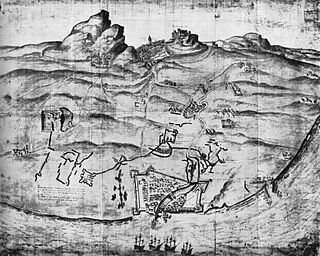 W
WThe Auld Alliance was an alliance made in 1295 between the kingdoms of Scotland and France for the purpose of controlling England's numerous invasions. The Scots word auld, meaning old, has become a partly affectionate term for the long-lasting association between the two countries. And although it was never actually officially revoked, it is considered by some to have ended with the signing of the Treaty of Edinburgh in 1560.
 W
WThe Battle of Baugé, fought between the English and a Franco-Scots army on 22 March 1421 at Baugé, France, east of Angers, was a major defeat for the English in the Hundred Years' War. The English army was led by the king's brother Thomas, Duke of Clarence, while the Franco-Scots were led by both John Stewart, Earl of Buchan, and Gilbert de Lafayette, the Marshal of France. English strength was 4,000 men, although only 1,500 deployed, against 5,000 French and Scots.
 W
WThe Garde Écossaise was an elite Scottish military unit founded in 1418 by the Valois Charles VII of France, to be personal bodyguards to the French monarchy. They were assimilated into the Maison du Roi and later formed the first company of the Garde du Corps du Roi.
 W
WThe Siege of Leith ended a twelve-year encampment of French troops at Leith, the port near Edinburgh, Scotland. The French troops arrived by invitation in 1548 and left in 1560 after an English force arrived to attempt to assist in removing them from Scotland. The town was not taken by force and the French troops finally left peacefully under the terms of a treaty signed by Scotland, England and France.
 W
WThe Siege of Orléans was the watershed of the Hundred Years' War between France and England. It was the French royal army's first major military victory to follow the crushing defeat at the Battle of Agincourt in 1415, and also the first while Joan of Arc was with the army. The siege took place at the pinnacle of English power during the later stages of the war. The city held strategic and symbolic significance to both sides of the conflict. The consensus among contemporaries was that the English regent, John of Lancaster, would have succeeded in realizing his brother the English king Henry V's dream of conquering all of France if Orléans fell. For half a year the English and their French allies appeared to be winning but the siege collapsed nine days after Joan's arrival.
 W
WThe Treaty of Berwick was negotiated on 27 February 1560 at Berwick-upon-Tweed. It was an agreement made by the representative of Queen Elizabeth I of England, the Duke of Norfolk, and the group of rebellious nobles known as the Scottish Lords of the Congregation. The purpose was to agree the terms under which an English fleet and army would come to Scotland to expel the French troops who were defending the Regency of Mary of Guise. The Lords were trying both to expel the French and to effect the Scottish Reformation, and this led to rioting and armed conflict.
 W
WThe Auld Alliance Trophy is a trophy in rugby union awarded to the winner of the annual Six Nations Championship match between France and Scotland.
 W
WThe Battle of Verneuil was a strategically important battle of the Hundred Years' War, fought on 17 August 1424 near Verneuil in Normandy and a significant English victory. It was a particularly bloody battle, described by the English as a second Agincourt.